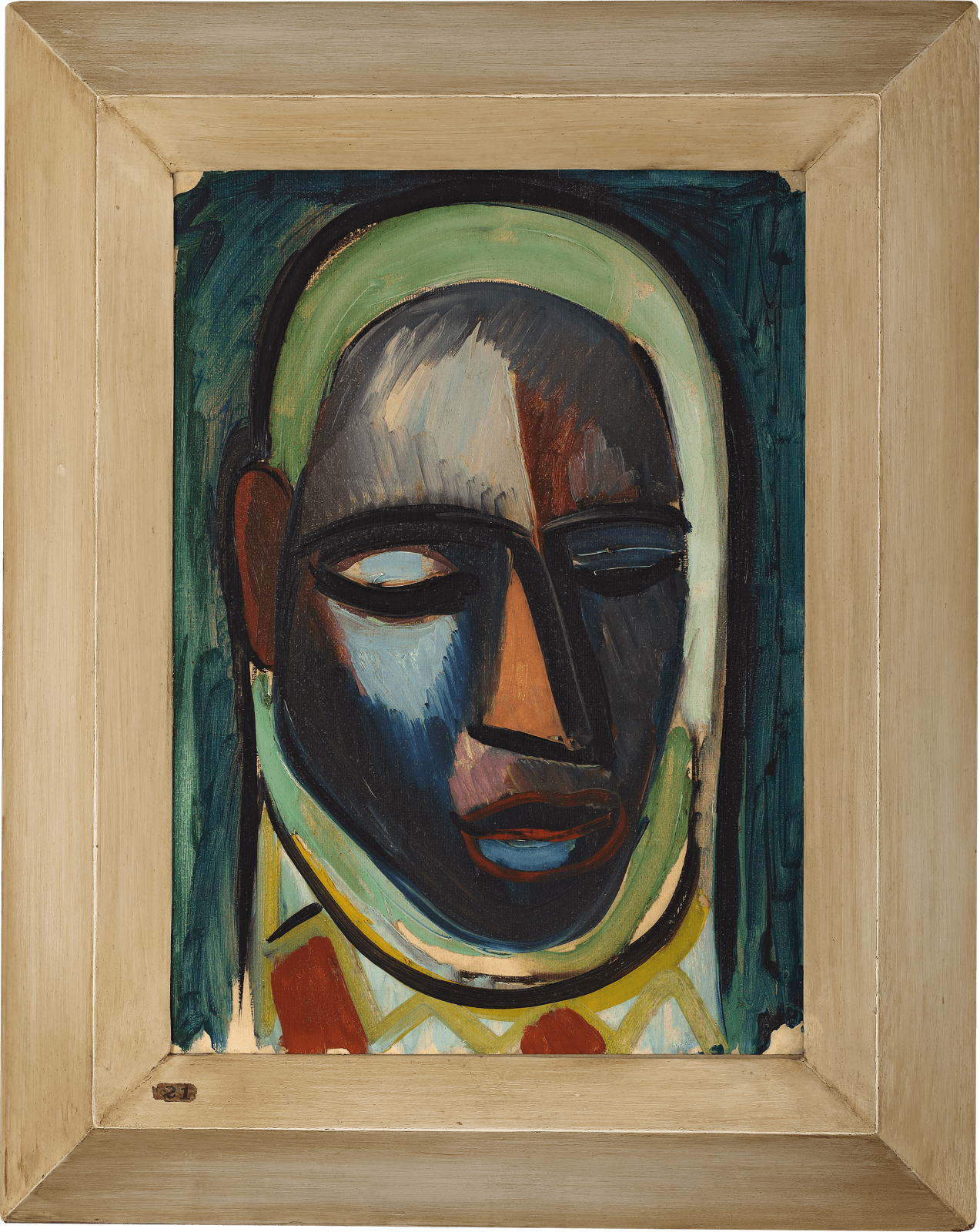
Edward Wolfe
Further images
Known in his lifetime as ‘England’s Matisse’ Edward Wolfe is now widely celebrated for his vibrant portraits, vivid still lifes and sweeping landscapes. Wolfe was born in South Africa and moved to England in 1916 to pursue a career in the arts. This immensely rare ‘mask-like’ portrait crystallises Wolfe’s expertise as a virtuoso colourist.
The intersecting lines which dominate this composition evince Wolfe’s confidence as a draftsman. He was emboldened by the British enthusiasm for post-impressionism, taking particular inspiration from the concentrated forms and vibrant colours employed by the likes of Henri Matisse. Fusing bold lines with vivid pigments, this subject’s face is modelled according to interrelated planes of intense, rich colour which became a hallmark of Wolfe’s practice.
The ‘mask-like’ features of the face are equally evocative of modern developments in European art. Non-Western masks strongly influenced the development of Western art movements such as Fauvism and Cubism, and mask-like faces became a key feature of many avant-garde artists' work. It is hard to determine exactly where Wolfe’s inspiration originated, as most Western artists working in the early-twentieth century recurrently grouped together the distinct visual arts of individual cultures across diverse regions in Africa, Oceania, indigenous America and Asia. As Wolfe was South African and born in Johannesburg, the present mask may have been inspired by the masks of the surrounding regions, although this cannot be confirmed with any certainty.[1]
Wolfe was highly influenced by Gaudier Brzeska who, like Wolfe, had moved to London to pursue a career in the arts and worked at the Omega Workshops from 1913. Brzeska engaged with so-called ‘primitivism’ and developed a direct, rough-hewn style of craftsmanship which had a profound impact on the young Wolfe on his arrival in London in 1916. The brazen and spontaneous lines which govern the present work exhibit this early influence on Wolfe, which remained paramount to his style throughout his career.
Although Wolfe was associated with contemporary movements and circles, such as the Bloomsbury group, he never fully devoted himself to one group. His biographer, John Russel, astutely observes that Wolfe ‘retained a quality of the outsider-by-choice’, but thanks to his charming character and artistic talent, Wolfe found it easy to immerse himself within the artistic elite of the time.[2] He had attended The Slade School of Fine Art where he met artists such as Nina Hamnett – who assisted him in obtaining a job at the Omega Workshops - Ambrose McEvoy, and members of the Bloomsbury group.
This work was exhibited with the London Artists Association, which ran from 1925 to 1933. It was masterminded by Samuel Courtauld and John Maynard Keynes at the instigation of Roger Fry and was designed to provide artists with a basic regular income whilst exhibiting and selling their work. Alongside the likes of Duncan Grant, Vanessa Bell and William Roberts Wolfe exhibited with the LAA every year between 1927 and 1933, including their retrospective exhibition in 1934. The LAA label on the reverse of the board and the exhibition number on the front of the original frame suggests that this work was exhibited with the group, likely in 1928, which would place this work within the height of Wolfe’s powers as an artist.[3]
[1] Wolfe had also recently returned from a painting trip across North Africa in 1928.
[2] J. Russel, Edward Wolfe, London: Trefoil books, 1986, p. 5.
[3] Examples of any exhibition catalogues held by the London Artists Association in 1928 are unfortunately now lost; however, this work is not recorded in any other exhibition catalogues produced by the Association between the years 1927-1934.
Provenance
Private Collection;Ursula Ridley, West Hoathly, West Sussex;
Thence by descent.
Exhibitions
The London Artists' Association, Cooling Galleries, London, probably 1928.Be the first to hear about our available artworks
* denotes required fields
We will process the personal data you have supplied in accordance with our privacy policy (available on request). You can unsubscribe or change your preferences at any time by clicking the link in our emails.
